
Rating process
You define the rate cards in the 2nd step of creating your price plan. Togai offers maximum flexibility when it comes to the types of supported rate cards.
Fixed fee
Model recurring / one-time platform and subscription fees
Usage based
Pay-as-you-go consumption based models
License
Seat, contact, user, record or license based pricing
Entitlement
Price features that require restricted usage or access
Overage
Allow pre-paid models with flexibility to go over restricted usage
Credit
Model promotional discounts as well as minimum commitments
Fixed fee rate card
Fixed fee rate cards are used to model a flat pricing that does not have any input quantity. You can model one-time purchases such as setup fees and professional services or recurring fees such as platform subscription fees and bill your customers.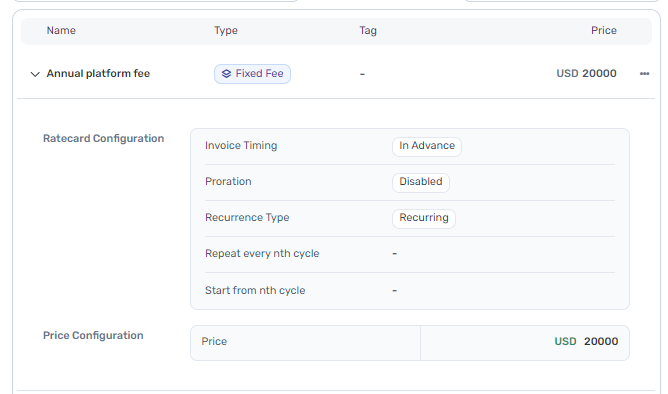
Example of a fixed fee recurring rate card
Usage based rate card
This rate card is used to create a pay-as-you-go consumption based component in your price plan with different types of slabs (tier/volume) and pricing types (per unit/package).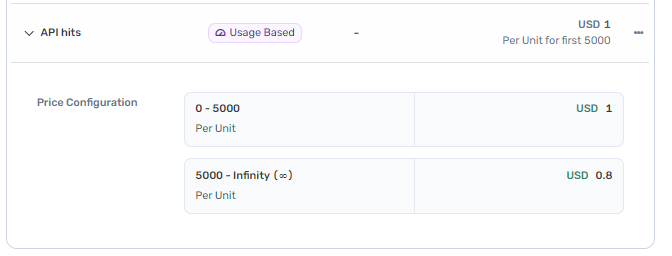
Example of a usage based rate card
License rate card
License rate cards are used to configure a seat based pricing model or one where you charge on users. It can also be used to model other actions that require persistance across billing cycles. Examples can be total data stored by your customer, number of Zaps configured or momentary usages that have increments/decrements such as parallel tests being run for a testing platform. You can provide different slabs and pricing types in this rate card. Some important points to note for a License rate card -- There are 4 types of behaviours for a license rated card based on the configurations chosen for Invoice Association (In Advance or In Arrears) and Proration option
- Currently, the granularity for a license rate card is per day. Let’s take an example of a postpaid user based pricing which is modeled as a license rate card with In Arrears configuration. Now if the customer adds/removes users multiple times within a single day, the invoice will combine the entire set of operations done into a single usage quantity for that particular day.
- If proration is enabled, the max number of license values on a particular day is taken as the usage quantity for rating and invoicing.
- The revenue metrics (positive or negative) for license rate cards are computed for the entire duration of the cycle as on the date of addition/deletion of the license quantities, irrespective of proration.
- For In Advance license with proration enabled, if a customer decreases the number of license quantities, the difference amount owed back to the customer for the remaining period of the cycle is added to the customer’s account as a credit balance. This balance can be netted off against subsequent invoices of the account.
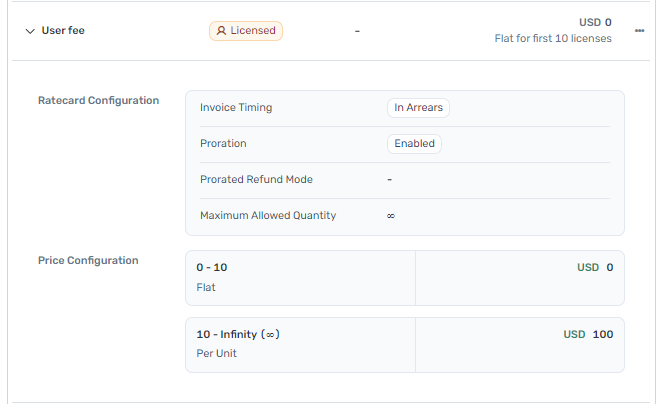
Example of a license rate card
Entitlement rate card
Entitlement rate cards are used to model a pre-paid committed purchase which comes with restriced usage/access. You can create a custom entitlement cycle within your overall billing cycle allowing for extreme flexibility.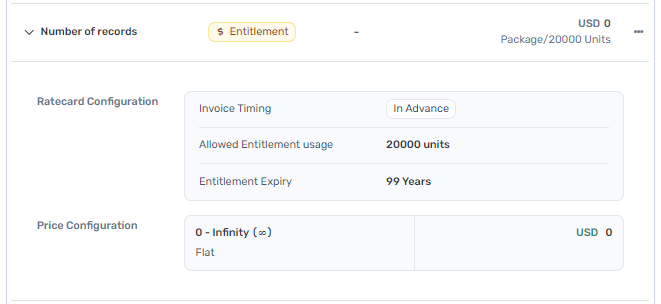
Example of an entitlement rate card
Entitlement Overage rate card
When you sell to large customers, you would have minimum commitments but not want to restrict their usage when they cross the agreed upon committed values. This can be easily modeled as an Overage rate card within Togai which is similar to a usage based rate card but is applicable only upon the entitlement threshold getting breached.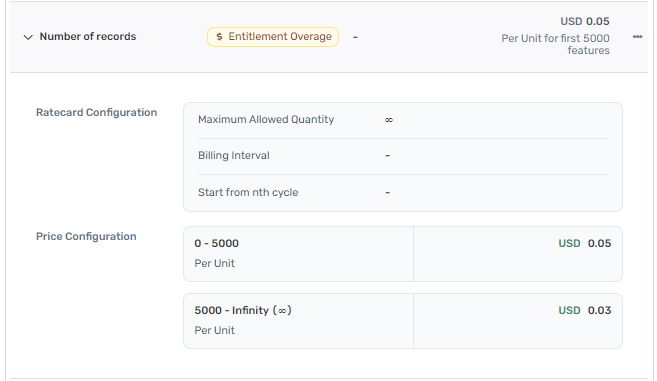
Example of an overage rate card
Credit grant rate card
Credit grant rate cards have 2 use cases in Togai -- Marketing promotions and discounts - you can offer a free currency credit to your customers for any amount and have them applied to specific line items of your invoice. This can be used to model any type of upfront promotion or adhoc discounts.
- Minimum commitments for individual line items - You can create a credit grant with a purchase price associated for the minimum commitment amount and associate them to specific line items or group of items in your invoice to model high configurability in your minimum commitments.
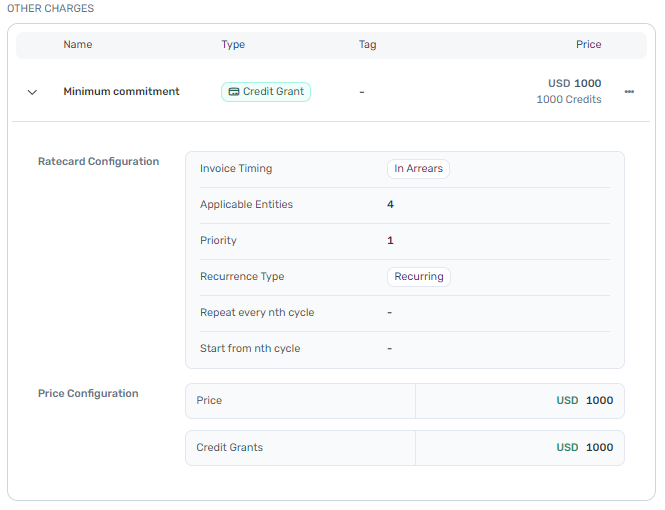
Credit grant rate card used to model minimum commitment
Important note
You can have only 1 rate card per billable item in a price plan. You cannot create 2 or more rate cards for the same billable item (usage meter/add-on/feature) within a single price plan.
Minimum commitment
If your minimum commitment requirement is at an overall plan/contract level, this can be modeled simply as a plan minimum that will be applicable in your overall invoice.Rate card common entities
In this section, let’s go through a few common entities across the rate cards - Invoice association - In Arrears means that this fee will be invoiced (becomes DUE) at the end of the billing cycle. In Advance would mean this rate card is invoiced (becomes DUE) at the beginning of the cycle.This option is not available for Usage and Entitlement overage rate cards which will always be invoiced In Arrears
Pricing model
Togai provides 3 configurations for pricing models and types. Pricing model in Togai allows you to configure tiers of pricing slabs based on usage quantity. These are applicable for rate cards where there is a usage quantity - Usage fee rate card, License rate card and Entitlement overage rate card.Standard
This allows you to setup a single tier of pricing for any usage quantity.Tiered
This model allows you to create any number of slabs based on usage quantities that can each be priced individually.Volume
This model allows you to create any number of slabs based on usage quantities where the pricing is dependent on the final slab the usage quantity falls upon the invoice becoming DUE.Pricing type
Pricing type allows you to define the per unit pricing for your rate card. These are applicable for rate cards where there is a usage quantity - Usage fee rate card, License rate card and Entitlement overage rate card.Flat
This pricing type allows you to configure a fixed fee for the entire usage slab chosen.Per unit
This allows you to create a pay-as-you-go based pricing for the chosen usage slab.Package
This option provides you the flexibility to charge per bundle where you can define your own bundle/package size. Example of a package is say $10 per 1000 API hits where 1000 is the package size and customer has to pay in increments of 1000 (package size).Max and min
These provide floor and ceiling price limits for your slab, the customer will be charged atleast the floor price (min) and atmost the ceiling price (max) if these are configured in your rate cards.Simple configuration for a complex contract
Let’s take an example of a CRM product whose contract has the following clauses -- An annual fixed platform fee of $20,000 charged upfront that includes
- 10 free users and $100 per user per month above that with pro-ration and charged along with usage based fee
- First 1000 contacts free, with $1 for additional 10 contacts upto a maximum of 5000 contacts - for more, please contact us
- Limit download to 20000 records per month
- Overage price of 0.05 USD per record upto 25000 records and 0.03 USD per record after that
- Allow unused records to roll-over to next month’s free usage limit
- An API product that is priced at 1 USD per unit for the first 5000 and has a volume based slab of 0.8 USD per unit beyond that
- Initial one-time setup fee of $5000
- Minimum usage commitment of $1000 per month
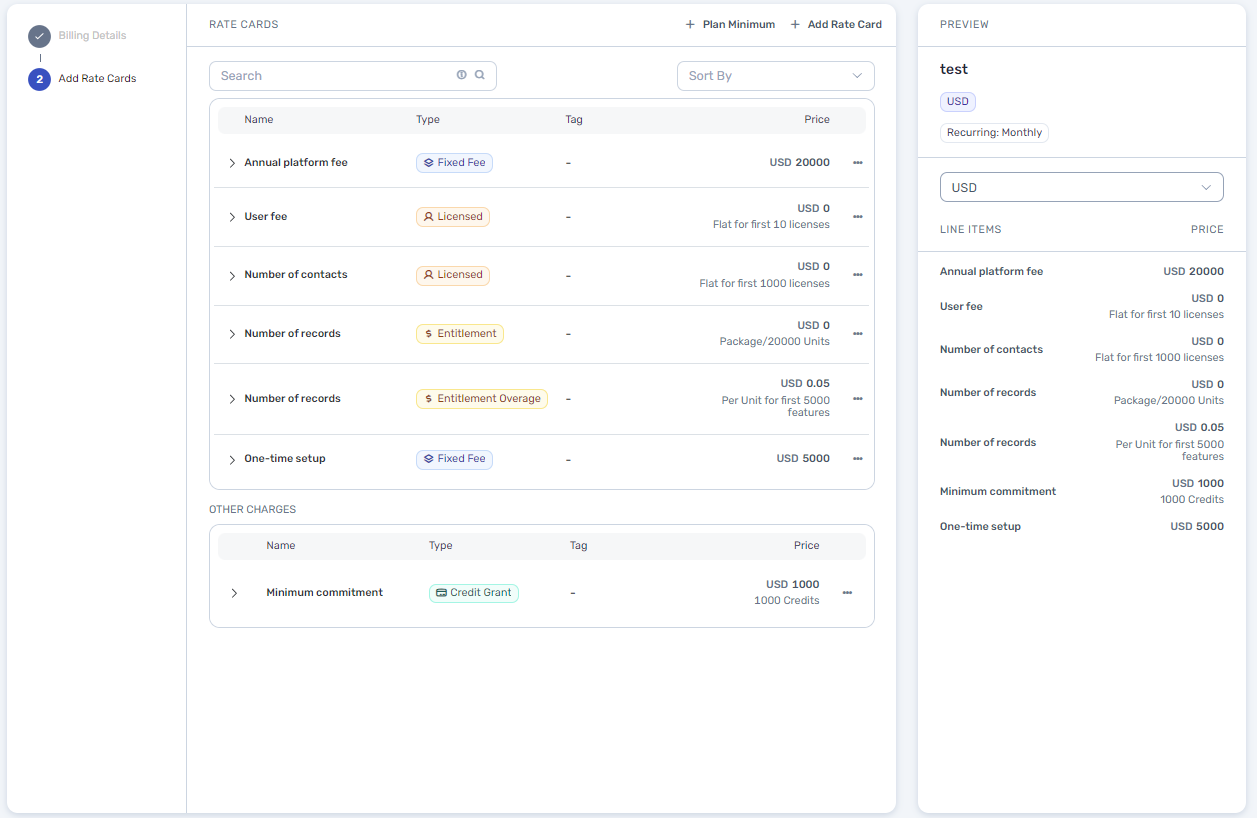
Simple configuration for a complex contract

